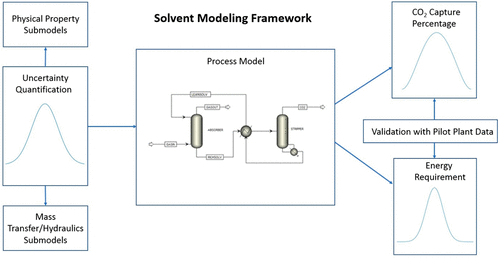当前位置:
X-MOL 学术
›
Ind. Eng. Chem. Res.
›
论文详情
Our official English website, www.x-mol.net, welcomes your
feedback! (Note: you will need to create a separate account there.)
Development of a Rigorous Modeling Framework for Solvent-Based CO2 Capture. Part 2: Steady-State Validation and Uncertainty Quantification with Pilot Plant Data
Industrial & Engineering Chemistry Research ( IF 3.8 ) Pub Date : 2018-07-13 , DOI: 10.1021/acs.iecr.8b01472 Joshua C. Morgan 1, 2 , Anderson Soares Chinen 1 , Benjamin Omell 2 , Debangsu Bhattacharyya 1 , Charles Tong 3 , David C. Miller 2 , Bill Buschle 4 , Mathieu Lucquiaud 4
Industrial & Engineering Chemistry Research ( IF 3.8 ) Pub Date : 2018-07-13 , DOI: 10.1021/acs.iecr.8b01472 Joshua C. Morgan 1, 2 , Anderson Soares Chinen 1 , Benjamin Omell 2 , Debangsu Bhattacharyya 1 , Charles Tong 3 , David C. Miller 2 , Bill Buschle 4 , Mathieu Lucquiaud 4
Affiliation

|
The U.S. DOE’s Carbon Capture Simulation Initiative (CCSI) has a strong focus on the development of state of the art process models for accelerating the development and commercialization of postcombustion carbon capture system technologies. One of CCSI’s goals is the development of a process model that will serve not only as a definitive reference for benchmarking of the performance of solvent-based CO2 capture systems but also as a framework for the development of highly predictive models of advanced solvent systems. In Part 1 of this paper and previous work, submodels for the system were developed, including those for physical properties, kinetics, mass transfer, and column hydraulics, by calibrating model parameters to fit relevant experimental data. For individual submodels, a Bayesian inference methodology was used to refine the estimates of the parameter values and to quantify the parametric uncertainty of the models. This work is focused on incorporating these submodels into a complete process model and validating this model with large scale pilot plant data from the Pilot Solvent Test Unit (PSTU) at the National Carbon Capture Center (NCCC). The model has been validated with data representing a wide range of operating conditions for absorber and stripper columns, including variable packing height and presence of intercooling in the absorber. The uncertainty in the solvent composition is measured by comparing the process measurements at NCCC to standard laboratory techniques of a known uncertainty. Through a sensitivity study, this measurement uncertainty is used to provide insight into some discrepancy between model and data. Parametric uncertainty for various submodel parameters has been propagated through the process model to assess the resulting uncertainty in the key model outputs. Finally, a variance-based sensitivity analysis is used to provide insight into the relative contributions of parameters from various submodels to the overall uncertainty of the process outputs in various operating regimes.
中文翻译:

开发基于溶剂的CO 2捕集的严格建模框架。第2部分:使用试验工厂数据进行稳态验证和不确定性量化
美国能源部的碳捕集模拟计划(CCSI)着重于开发最新工艺模型,以加速燃烧后碳捕集系统技术的开发和商业化。CCSI的目标之一是开发一种过程模型,该模型不仅可以作为基准基准,用于确定基于溶剂的CO 2的性能捕获系统,也可作为开发高级溶剂系统的高度预测模型的框架。在本文的第1部分和以前的工作中,通过校准模型参数以适合相关的实验数据,开发了该系统的子模型,包括物理特性,动力学,传质和柱水力学的子模型。对于单个子模型,使用贝叶斯推理方法完善参数值的估计并量化模型的参数不确定性。这项工作的重点是将这些子模型整合到完整的过程模型中,并使用来自国家碳捕集中心(NCCC)的中试溶剂测试装置(PSTU)的大规模中试工厂数据验证该模型。该模型已经用代表吸收器和汽提塔广泛操作条件的数据进行了验证,包括可变的填充高度和吸收器中存在中冷。通过将NCCC的过程测量值与已知不确定性的标准实验室技术进行比较,可以测量出溶剂组成的不确定性。通过敏感性研究,可以使用这种测量不确定性来洞察模型与数据之间的某些差异。通过过程模型传播了各种子模型参数的参数不确定性,以评估关键模型输出中所产生的不确定性。最后,
更新日期:2018-07-14
中文翻译:

开发基于溶剂的CO 2捕集的严格建模框架。第2部分:使用试验工厂数据进行稳态验证和不确定性量化
美国能源部的碳捕集模拟计划(CCSI)着重于开发最新工艺模型,以加速燃烧后碳捕集系统技术的开发和商业化。CCSI的目标之一是开发一种过程模型,该模型不仅可以作为基准基准,用于确定基于溶剂的CO 2的性能捕获系统,也可作为开发高级溶剂系统的高度预测模型的框架。在本文的第1部分和以前的工作中,通过校准模型参数以适合相关的实验数据,开发了该系统的子模型,包括物理特性,动力学,传质和柱水力学的子模型。对于单个子模型,使用贝叶斯推理方法完善参数值的估计并量化模型的参数不确定性。这项工作的重点是将这些子模型整合到完整的过程模型中,并使用来自国家碳捕集中心(NCCC)的中试溶剂测试装置(PSTU)的大规模中试工厂数据验证该模型。该模型已经用代表吸收器和汽提塔广泛操作条件的数据进行了验证,包括可变的填充高度和吸收器中存在中冷。通过将NCCC的过程测量值与已知不确定性的标准实验室技术进行比较,可以测量出溶剂组成的不确定性。通过敏感性研究,可以使用这种测量不确定性来洞察模型与数据之间的某些差异。通过过程模型传播了各种子模型参数的参数不确定性,以评估关键模型输出中所产生的不确定性。最后,











































 京公网安备 11010802027423号
京公网安备 11010802027423号